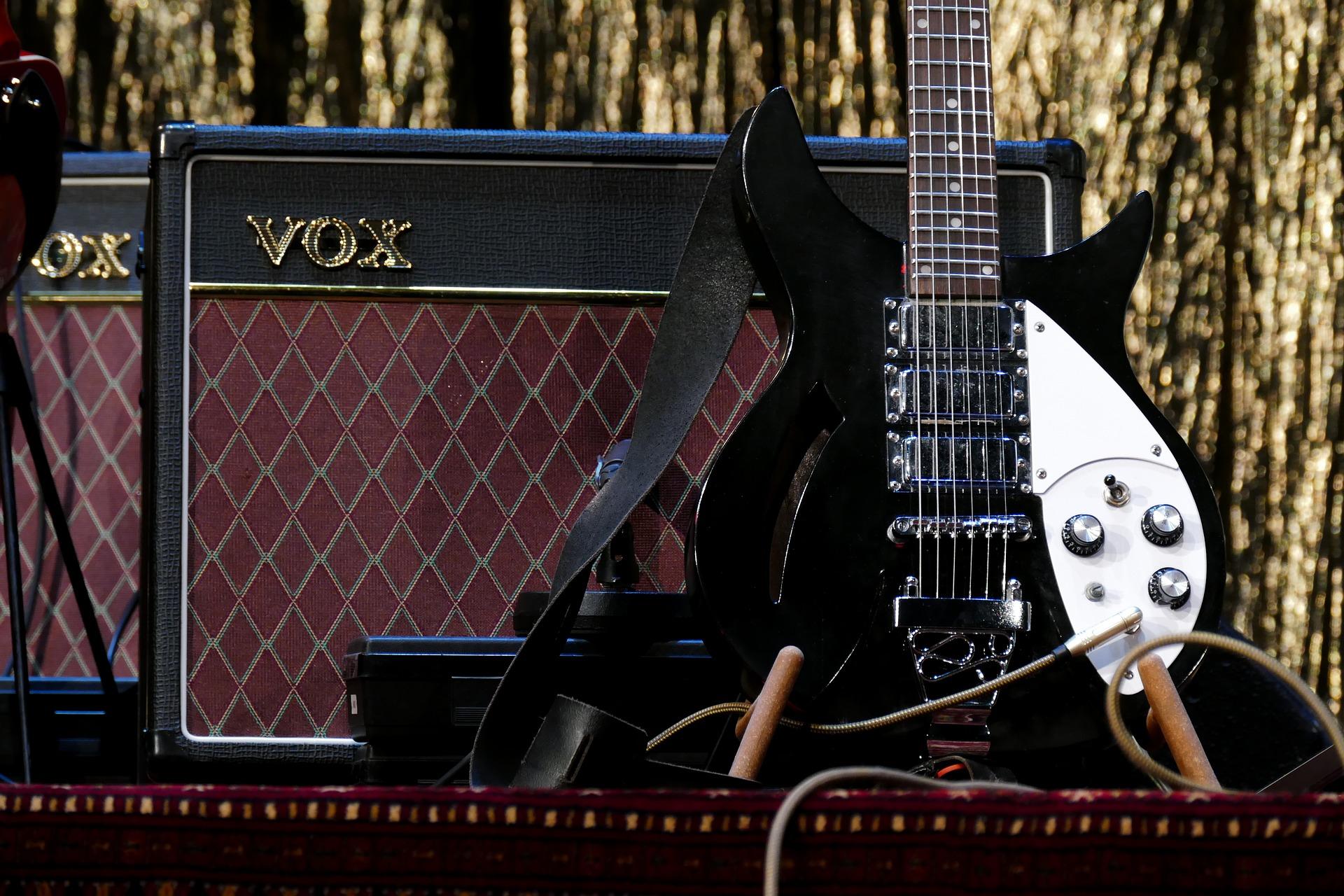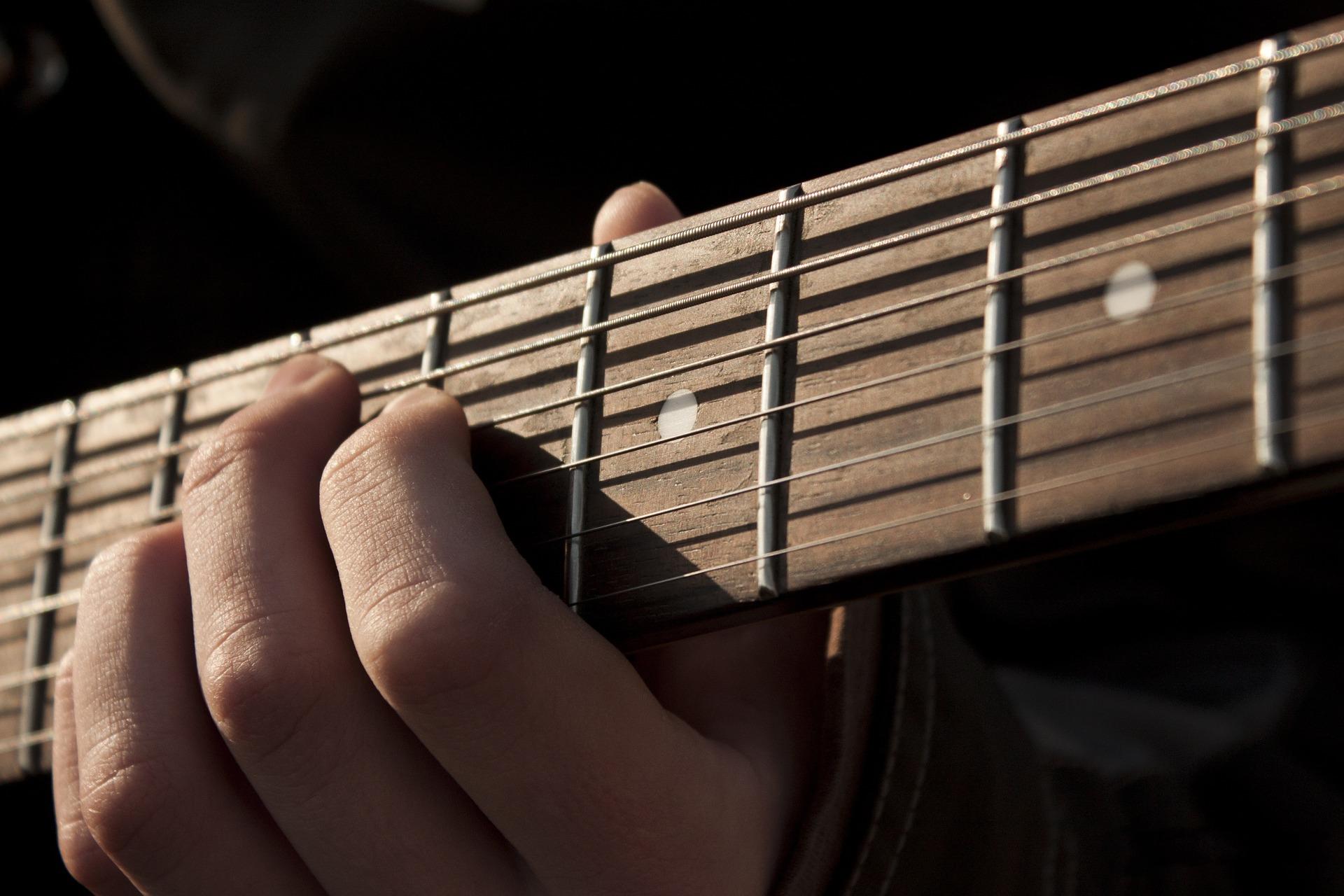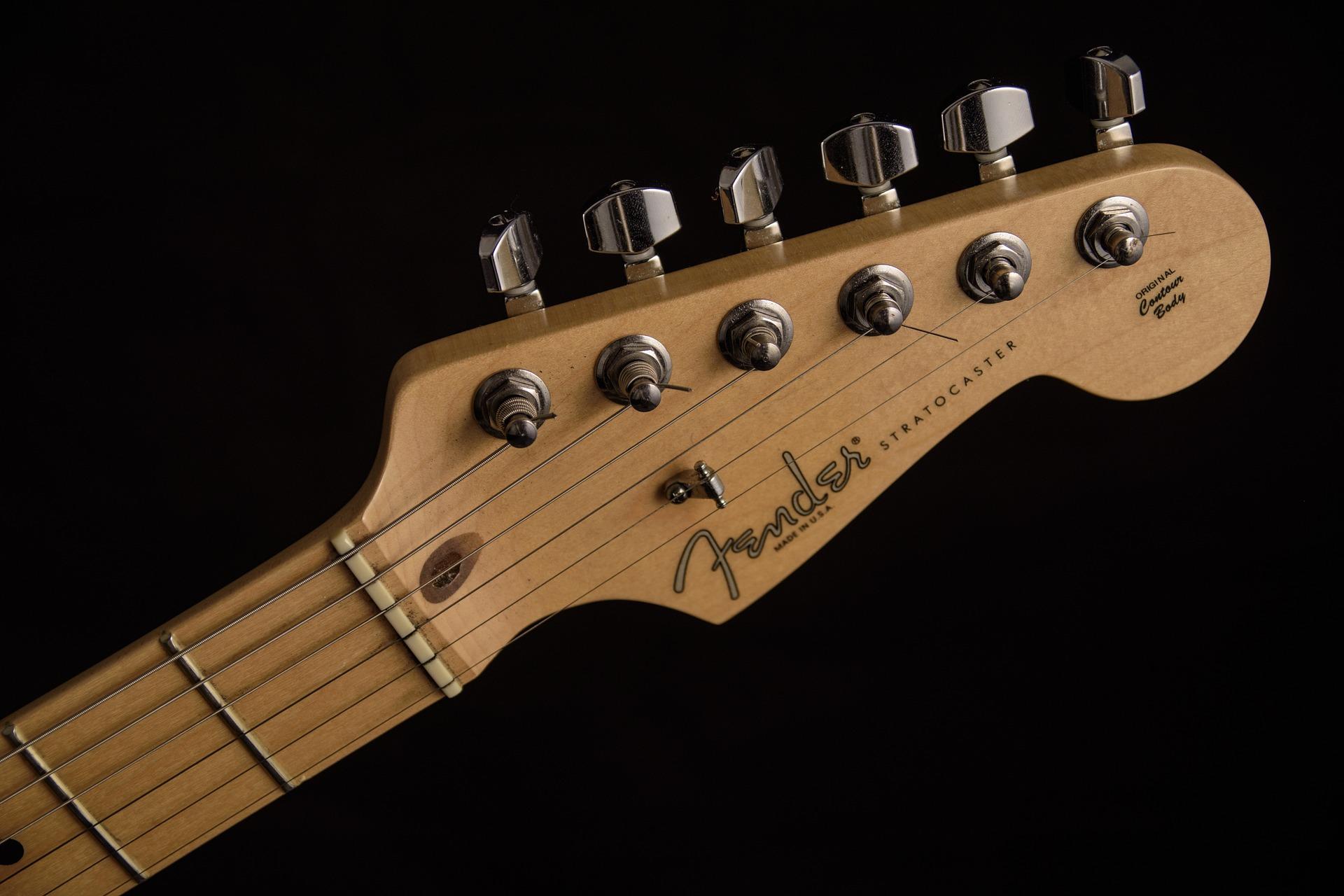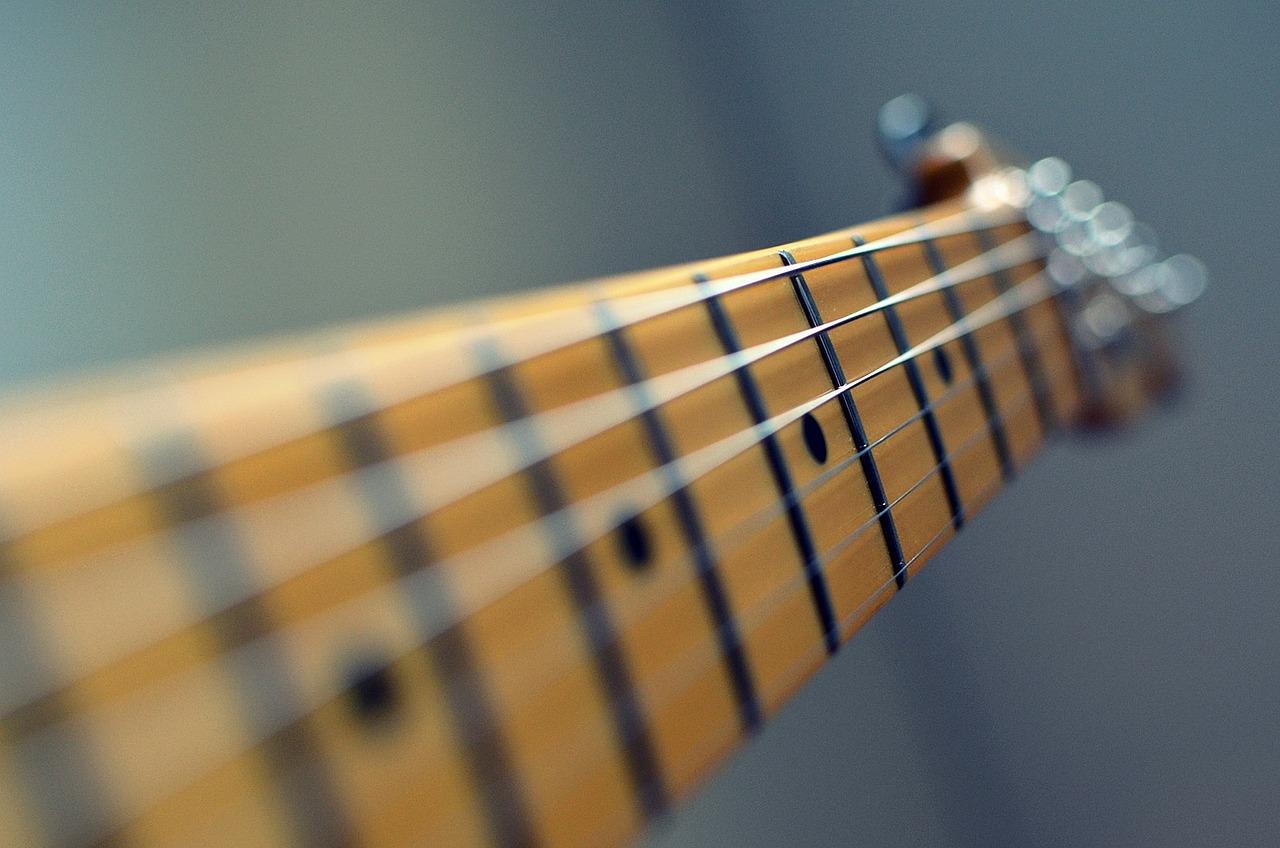“Music is the literature of the heart; it commences where speech ends.” - Alphonse de Lamartine
More and more Brits are taking to the stage. But before they do, they have the long and arduous task of learning how to play guitar. They need to learn the notes, the chords, rhythm, and even harmony.
Your first guitar may as well be from an alien planet if you've never owned a stringed instrument before. Each guitar player will have to get used to playing guitar, learn how to strum a chord, finger frets in a certain way, and tune a guitar with or without a tuner.
To help those who just started learning how to play the guitar and are still finding their way around the neck, we've got some tips and advice for you. It's a good idea for any musician to familiarise themselves with their instrument over a few guitar lessons before they start strumming some power chords on their new Stratocaster or Les Paul copy.

Firstly, What Do You Need To Play Guitar?
Many people wrongly assume that to play guitar, all you need is a guitar in hand. You will, of course, need a guitar (we'll let you know how best to choose your guitar below!), but you'll also need some basic kit to go with it. As elements of this guitar toolkit can change depending on what you intend to play, it is important to determine which style of music you wish to play with it, whether blues, rock, jazz guitar, classical.
If you didn't know already, each guitar style has a corresponding type of guitar: the electric guitar is perfect for rock and electric pieces, but acoustic is better for blues, pop and jazz.
Fans of classical or flamenco music will need a classical guitar (or a ukelele). Below are a few of the things you might need as a budding or experienced guitarist:
- An electric tuner to easily tune your guitar strings (more to come on this)
- A plectrum to strum with
- A spare set of strings in case of breakages
- A metronome (a device that marks time at a specifically chosen rate by giving a regular tick.)
How to Choose Your Guitar
It is not advisable to buy your first guitar online at the cheapest price or taking a hand-me-down, however sentimental it is.
Your guitar should be carefully selected in accordance with a few factors, one of which being the type of music you would like to play.
There are 3 kinds of guitars:
- The classical guitar, with nylon strings
- Acoustic, or folk guitars, which have a similar shape to classical guitars, but with metallic strings
- Electric guitars which need to be plugged into an amp in order to play
What's more, guitars come in various shapes and sizes:
- A 1/4 guitar, meant for the smallest players
- A 1/2 guitar, suitable for average-sized children - say, of primary school age
- A 3/4 guitar: the next size up, meant for the average-sized preadolescent
- A normal (full size) guitar for children over the age of 12 and adults
So, as you can see, guitars are not a one-size-fits-all proposition.
Tune Your Guitar
Now that you've picked your guitar, you need to learn how to tune it.
There are many ways to tune your guitar, some traditional some more sophisticated. Here are the different methods:
- The tuning fork: An inexpensive device that requires you to hit the fork on a hard surface and let it ring to make an A, then you tune your guitar accordingly.
- The dialing tone of your landline telephone (it plays a perfect A)
- The adjacent strings technique (also called the 'Beat Method'): After using an open string note, you use this as a basis to tune the other strings.
- Electric or electronic tuner: A device that you plug in, play an open string and watch for the position of the needle. You just have to tighten or loosen your string to get the desired chord - once you've tried it you won't go back!
- An on-line tuner: You'll need a good internet connection but you can then choose from one with an audio capture or one without, each offering their own advantages.
- Your smartphone, using a guitar tuning app: there are various apps that you can use which work exactly like an electronic tuner.
To begin the guitar, you will have to learn the basics and the main techniques - fingerstyle, the placement of your index, middle finger and thumb, and basic chords, like the major, minor and seventh chords. Below is more info about the guitar neck to help you familiarise yourself with the musical instrument.
Check for exceptional online guitar lessons here.
The Basics of a Guitar Neck
The guitar is made of the three main parts: the head, the neck, and the body.

What Makes Up a Guitar's Neck?
Let's focus on the neck because it's the part where your left hand (if you're right-handed) presses down on the strings in order to produce a given note. The neck includes a fretboard complete with frets.
The neck is made of a single piece of wood, usually mahogany, maple, or cedar. The fretboard sits atop this single piece of wood and is made of a harder wood such as ebony, rosewood, or maple. Usually, the fretboard has between 19 and 22 frets (though sometimes more) which are made of nickel, zinc, or brass and allow the guitarist to shorten the part of the string that's vibrating. Each fret is a semitone apart.
Guitar strings are suspended over the neck and the frets. The neck is joined to the head at the nut. The other end of the neck is joined to the body.
If you want to play your new guitar, you need to either play the string open by not pressing down anywhere on the neck or play a given note by pressing down clearly on the frets.
The Layout of the Neck
Are you good at math?
It's thanks to math that the distances between frets can be calculated. In fact, math plays a huge role in music theory for guitarists. Whether you're playing folk guitar, jazz guitar, electric guitar, here are some things you should know:
- The notes B and C and E and F have no semitone between them.
- Every other note is two frets apart.
- You should memorize the open notes on each string in standard tuning: E, A, D, G, B, e.
Since an octave spans twelve semitones, the note of each open string repeats on the 12th fret. - In standard tuning, each string is five semitones higher than the previous, with the exception of the B string which is only four semitones higher than the G string. For example, if you play the fifth fret on the E string, you'll play an A, this same as the open note on the following string.
- This works for any string except the G string.
Of course, it's all well and good knowing the principles but you've also got to know how to use them.
What Are the Inlays on the Neck of a Guitar For?
You might have noticed that there are little circles, squares, or diamonds on the neck of your guitar. These can come in really handy when playing the guitar.
Find good online guitar lessons here.

The Inlays don't Indicate which Note You're Playing
A lot of beginners think that these inlays on their electric guitar or acoustic guitar are there to represent the notes. However, after one or two lessons, you'll know this isn't true.
Unfortunately, it’s not as easy as you might think! They are there to help you but they won't tell you if you're playing a C, F, or an A.
On instruments such as the piano, there's a clear difference between the white keys and the black keys.
However, on a guitar, the same notes appear several times across the neck and on different frets. In some cases, a fret with an inlay may play a C and elsewhere on the neck, the same C mightn't have an inlay on it.
Working out which fret plays with notes requires a bit more thinking than playing a given note on the piano.
Where are the inlays?
You can see the inlays between the frets and on the edge of the fretboard facing the guitarist's head.
There are usually two inlays instead of one on the 12th fret to differentiate it from the others. This allows you to quickly find the octave for the open string.
The lowest string is an E. If you play the 12th fret on this string, you'll also play an E but an octave higher.
The inlays can be found on the odd-numbered frets with the exception of the first, eleventh, thirteenth, which don't usually have inlays, and the twelfth fret, which usually does.
Thus, there are inlays on frets 3, 5, 7, 9, 12, 15, 17, 19, 21.
If you an electric guitar, you may have up to 24 frets. The 24th fret will usually have the same inlays as the 12th.
You should also work out your level as a guitarist.
What are the Inlays for?
As you may have understood, the inlays are there to help you quickly find a given fret. This is particularly useful if you're playing along with guitar tablature which indicates the fret number to play.
Whether you're are playing a Telecaster, an Ibanez, or Gibson, you'll be able to see the inlays, though they may be different to other guitars. They might be more discreet than on other guitars, but they're still there.
If you really don't have any, you can always add them yourself if you're a beginner and need help.
Find good guitar lessons here on Superprof.
How Can You Find the Notes on a Guitar's Neck?
Whatever kind of music you like and regardless of whether you're playing a Fender Strat or a classical guitar, you'll need to know where you can find each note on each string on your guitar.

The neck on your guitar will help you find all the notes.
To start, you have to learn and notes of each open string. Usually, from the lowest to the highest, strings are tuned to E, A, D, G, B, e.
Additionally, you should be aware that:
- There is a semitone between each fret.
- Between E and F and B and C, there is no semitone. In fact, there is no such thing as E sharp or B sharp.
- Between every other note, there is a semitone.
For example, if we start with the E string, you'll hear the following notes along the neck with the open fret being E.
- 1st fret: F
- 2nd fret: F#
- 3rd fret: G
- 4th fret: G#
- 5th fret: A
- 6th fret: A#
- 7th fret: B
- 8th fret: C
- 9th fret: C#
- 10th fret: D
- 11th fret: D#
- 12th fret: E (octave)
The same is true for all the other strings, you just have to start from a different note.
Easy, isn’t it?
Other Techniques for Familiarizing Yourself with the Neck of a Guitar
The interval technique
To use this technique, you just need to be aware that each string is separated by a fourth, with the exception of the G and B strings which are separated by a third major interval.

In essence, this is what allows guitarists to easily play certain chords. Some chords would be almost impossible to play if the intervals with different.
However, there is a certain problem with this tuning: the harmonies between the strings. This doesn't really work between the G and B strings.
For example, the octave intervals played on the sixth and fourth strings won't sound right on the fourth and second strings.
To avoid this problem, you need to consider the neck and its strings as two separate parts:
- The low strings: The 6th, 5th, 4th, and 3rd strings.
- The high strings: 2nd and 1st strings.
If you’re playing across the two sets of strings, just make sure you add an extra fret to what you would usually play to make the octave.
This will ensure that you maintain the fourth harmony.
Octave Triangles
We've got some more math for you…
Thanks to a triangle, you can play a single note on three different guitar strings. For example, if you play G on the third fret of the six string, you'll find G on the third fret and two frets up two strings lower, which would be the fifth fret on the fourth string.
If you're playing an E on the seventh fret on the fourth string, you know that you're on triangle's peak. The other As can be found two strings and two frets lower, on the six string and the fifth frets, and three strings higher and two frets lower, on the first string and the fifth fret.
Try using these different techniques and you'll soon see how they can help you find different notes on the neck.
A teacher may prove very useful because they will help you get to know the basic facts above. They may also talk you through the basics of improvisation, ear training, and chromatic technique exercises.

Learn the Basics of Guitar
It's a lovely idea, to pick up a guitar and be a self-taught guitarist selling out stadiums and arenas... sadly it's not as easy as that. The copious information listed above about one single instrument just goes to show this!
While it's great to be enthusiastic, it can be really beneficial to hire a teacher to walk you through some of the basics of guitar playing.
You can interview several teachers and check out several venues that offer guitar learning.
Such venues might include:
- A class at your local community center
- Classes at a music school
- Private lessons in a music shop
- Guitar classes with a private professor who can come to your house
Private lessons are naturally more personal and advantageous than being placed in a classroom full of other students of varying ability, talent and desire to learn, so if your budget can stretch to a private tutor then you should seriously consider this as your first option.
Private tutors also offer the most flexibility because you are the only student they are trying to please, rather than moving days and times around to try to fit in with ten or so other learners. If your options are limited for personal tutors in your area, then have you thought about looking for a tutor online? This doesn't mean to say you have to learn from a robot or by sitting in front of a computer (however remote teaching is normally an option if you so wish!), Superprof has hundreds of guitar tutors scattered all across the UK!
On the Superprof page, you can review tutor profiles: their background in music studies and their experience in teaching; what type of guitar they teach - say they only play acoustic guitar or fingerstyle guitar - what skill level they teach and testimonials from past students.
Plenty of Superprof guitar tutors offer lessons one-on-one or in small groups and have no trouble coming to your home for lessons. And, perhaps best of all, most Superprof tutors offer their first hour of lessons at no charge, just to see if you get along well enough to learn from them! That's right, they all offer free lessons!
Superprof is an excellent way to cut out all of the running around you would otherwise have to do to find the ideal guitar teacher for you! And, many of our tutors offer video guitar lessons and guitar lessons online.
As a guideline of what you could expect to learn when you start out playing the guitar, here's a rough timeline:
- to start out, you will learn about the chords, strumming patterns, and tabs. Your teacher will start to teach you different techniques like licks, barre, and finger picking. Then, you will most likely learn simple songs to practice again and again.
- once you are well-rehearsed in the practical aspects of the guitar, your teacher will guide you towards learning about musical theory and more technical aspects.
- further down the line, you will learn more complicated sequences, possibly even be encouraged to play in a band alongside other instruments or asked to sing whilst you play the guitar.
Classes will help give you both a good theoretical base and practical experience of playing the guitar.
Do You Need Guitar Lessons?
Learning an instrument can be daunting, especially if you are new to music. Still, you can learn to play this popular musical instrument through determination. Whether you want to learn how to play guitar physically or through guitar lessons online, you can maximize your efforts by learning essential things.
Choosing to play the guitar is a great way to explore new hobbies or broaden your musical knowledge. Good instructors make the process straightforward. As a newbie, you should play guitar regularly to brush up on existing knowledge. Below are some instructions for some reasons why you need guitar lessons.
Learn the basics
Before advancing in your lessons, you should know basic things about the instrument. This would help you build on a stronger foundation. For starters, learn parts of the guitar. The guitar has different parts, which have vital functions, helping the guitar produce quality sound. For one, the neck is where you hold your guitar. Most often, during your online guitar lessons, your instructor may require you to tune the instrument for better sound production. The body is another essential part, which assists you in picking strings. Strings align on the body, and inside the body is the hollow box.
Learn to play the chords
During your tutorial, your tutor may require you to play the guitar. This is the second step in guitar mastery. A chord is three or more notes that are played together. There are numerous kinds of notes you should practice on your instrument, starting with the basic ones before advancing.
Tune your guitar
Tuning a guitar makes it sound excellent. If you don't tune it properly, you may not enjoy the sound production. Luckily, most guitar lessons for beginners include tricks, which would help you play faster and also tune your instrument properly. It’s safe to note that there are many instructions on the internet to assure better guitar tuning.
Why Do You Need Guitar Lessons?
There are numerous reasons why you need guitar classes. While some people can learn ways to play instruments independently, most people need guitar lessons to help them master the instrument. Before learning to improve your guitar skills, you should look at why you need an online class.
- It’s faster
If you want to master the guitar within a short period, you need to find guitar lessons near me. While self-teaching is inexpensive, most people find it to be time-consuming. If you need to meet a time target for learning the guitar, you should find great tutors who are experienced in teaching beginners. Additionally, you may need to choose the kind of lessons you want, whether physical classes or online guitar tutoring.
- It keeps you motivated
When learning to perfect your guitar, you need adequate motivation to keep you on track. This makes it necessary to have a music tutor or to attend guitar training for greater understanding. Your tutor will motivate you while teaching you. They may also teach you new tips for faster learning. So, ensure you find a good guitar class to enjoy loads of benefits from an experienced tutor.

What Should You Expect from a Guitar Tutorial?
Attending lessons is one of the first steps you need for better insight as a student. But since you are a newbie, you need to understand certain guitar concepts. Oftentimes, instructors introduce you to aspects of guitar, such as parts and functions. Similarly, they may also teach you how to tune your guitar and hold the body.
When you have to know basic aspects of the guitar, you can progress to working the guitar. Like other instruments, you need to be interested in playing guitar to speed up learning. If you don't like the instrument, you may find it challenging to learn it.
Guitar parts
Your music tutor will teach you all the essential parts of the instrument, helping you understand its functions. Also, your tutor may show you ways to use your fingertips or a pick to play the instrument. If you plan on learning to play guitar with your fingers, you may find your fingers stinging after your classes. On the other hand, learning with a pick makes things easier for your fingers.
You will learn to tune
Tuning is a process of ensuring your guitar plays at the correct pitch. Tuning is an essential skill you learn when taking guitar lessons near me. Your instructor will show you how to tune your guitar during your first classes, ensuring it sounds excellent for your practice. Without proper tuning, your instrument will not sound right.
Should You Attend Guitar Lessons?
If you are having doubts about attending a tutorial, you should reevaluate your goals. The best guitar tutorial should educate you on playing the guitar and may also show you some guitar tricks, which will be useful when you start playing professionally. While most music schools are expensive, you should search for an excellent tutor ready to teach you everything you need to know within your budget.
Your instructor will improve your musical knowledge, helping you acquire essential knowledge. While you may not become a professional instrumentalist, playing the instrument is a fun and exciting process, which requires patience and perseverance.
Fortunately, when you attend a tutorial, you will have the inspiration to face the challenges ahead. Here are some reasons you need to attend lessons.
You learn from experienced tutors
Your tutors have also gone through the learning process, making many mistakes along the way. With their years of teaching and knowledge of playing, they can help you learn the best way. Attend guitar training for newbies to aid your learning process. Tutorials for beginners are structured specially for new learners, which ensures you learn everything you need to know.

You will know helpful guitar tricks
Guitar tricks are necessary if you want to learn within a short period. These tricks will assist newbies while enabling them to acquire playing skills. Also, when you become a professional, you can take guitar lessons online to start your learning goal. Similarly, if you opt for online lessons, you can attend classes from the comfort of your home, saving you time and money.
Guitar Tricks For New Learners
There are lots of tips you will find useful when learning. Guitars are beautiful instruments built to produce quality sound. However, to play, you must attend online classes for adequate insight. While attending your lessons, you can learn to play more easily when you:
Set goals
While playing, set your short and long-term goals for particular periods. For short-term goals, you can write what you hope to achieve in three months. Long-term goals, on the other hand, usually take longer. Write what you hope to achieve in the future in terms of your tutorial. Ensure these goals are realistic and don't feel bad when you struggle to meet them.
Don't compare yourself to others
Everyone has different tricks for learning, and this may help others learn faster. Don't be discouraged when others have covered more ground than you. Just be proud of what you've learned, and be eager to learn more. This makes it crucial to attend classes regularly with good instructors.
Practice regularly
Practicing is very important. Take time every week to go over lessons your instructors have taught you. This way, you will learn a lot about the guitar within a short while. Also, your guitar knowledge becomes better when you take time to go over topics taught in class. When you go over these topics, you will realize that lessons stick to your memory.
Get feedback
- While you work the guitar, make sure you get feedback from your instructor, as this would help you. So, when you are learning new chords or songs, you can show your instructor your learning progress. If you are getting something wrong, they can easily point you in the right direction. The best students often get regular feedback from their instructors. Take advantage of your training to maximize your potential.
Where Can You Learn Guitar Skills in Canada?
As a newbie, you might be looking for a great platform to learn guitar as beginners. Superprof is the best platform for learners globally. You need an instructor who is patient and knowledgeable about learning an instrument successfully. When your instructors have this quality, playing it becomes a straightforward process. Below are reasons why you should attend Superprof classes.
Availability of great tutors
Superprof has excellent guitar instructors who are experienced in teaching beginners like you. Besides guitar, Superprof is also a great platform to learn other instruments you find intriguing. This is because the platform is the largest platform for instructors worldwide. Additionally, tutors charge an affordable amount, helping you learn while sticking to a budget.
Well-structured learning
Superprof will help you learn in a structured and organized way. In most cases, tutors have syllabuses for guitar lessons for beginners, which helps them learn their favorite instrument quickly. Also, Superprof tutors are approachable and professional, helping you achieve your musical goals. This makes it easier for you to become a great instrumentalist.
During the more practical lessons, in-depth focus will be given to the basic parts of the guitar, including the guitar neck and how to place your fingers, the fretboard, and learning to tune your instrument. Therefore, after several lessons, you will be well on your way to playing (almost) like a pro!
Good luck!
















I think you need to review the part about triangles. The E note is not on the 4 th string and 7th fret. It is an ‘A’. I’m a beginner and self taught so I may be wrong. I’ve been playing for 6 months . I’m trying to learn fretboard and this seems incorrect from what I’ve learned so far